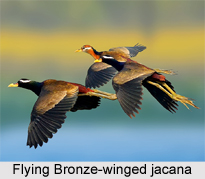 Bronze-Winged Jacana is an Indian Bird that bears a scientific name of "Metopidius indicus", concentrated in shallow lakes.
Bronze-Winged Jacana is an Indian Bird that bears a scientific name of "Metopidius indicus", concentrated in shallow lakes.
Identification of Bronze-Winged Jacana
Bronze-Winged Jacana is the only member of the genus Metopidius are identifiable by their huge feet and claws which enable them to walk on floating vegetation in the shallow lakes that are their preferred habitat. They are found worldwide within the tropical zone.
Breeding of Bronze-Winged Jacana
Bronze-winged jacana breeds in India and south-eastern part of Asia. It is sedentary apart from seasonal dispersion.
Eggs of Bronze-Winged Jacana
Bronze-Winged Jacana lays four black-marked brown eggs in a floating nest. The males, as in some other wader families like the phalaropes, take responsibility for incubation.
Structure of Bronze-Winged Jacana
Bronze-Winged Jacanas are 29 cm long, but the females are larger than the males. They are mainly black, although the inner wings are very dark brown and the tail is red. There is a striking white eye stripe. The yellow bill extends up as a red coot-like frontal shield, and the legs and very long toes are grey. Young birds have brown upperparts. Their under parts are white, with a buff fore neck.
Prey of Bronze-Winged Jacana
Bronze-Winged Jacana feeds on insects and other invertebrates picked from the floating vegetation or the water`s surface.
Behaviour of Bronze-Winged Jacana
Bronze-winged jacanas have a territorial, sex-role reversed system. They are polyandrous, and the females are larger and more brightly coloured than their male counterparts. The females compete with each other for harems of males to incubate their clutches of eggs. Each female"s territory encompasses one to four males and their individual territories.
Population Density of Bronze-Winged Jacana
The population density of breeding territories is limited by habitat availability and the territorial competition with other females and their harems.  Although there is no clear evidence for a relationship between male territory size and the distribution of available resources, heavier males have been shown to defend their territories from other males.
Although there is no clear evidence for a relationship between male territory size and the distribution of available resources, heavier males have been shown to defend their territories from other males.
Distribution of Bronze-Winged Jacana
The overall distribution of Bronze-Winged Jacana appears to be in small areas controlled by individual males, with the harems of females encompassing one or more of the male territories. Even though the territory size of females is positively correlated with the size of their harems, it does not seem to be related to the overall quality of the habitat. Females could attempt to maximize harem size by including as many male territories as they can, while males in larger harems would have to defend smaller territories. As a result, the degree of polyandry of the Bronze-winged jacana is dependent on the territory sizes of males and females.











